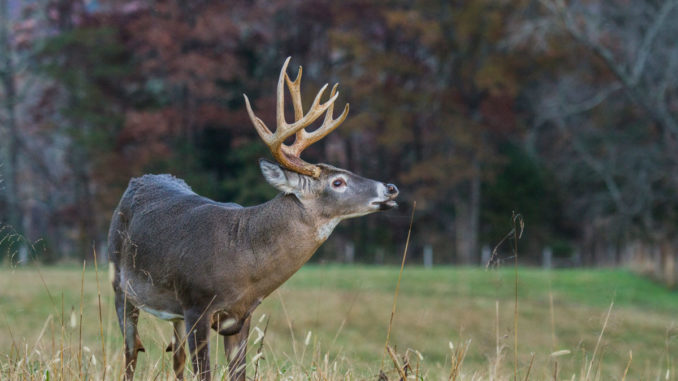
Commercial hunting operations in the Carolinas are apt to provide opportunities for visiting huntesr who want to target trophy bucks — or fill their freezers with venison. How do they manage for such different objectives? Here’s how….
The young buck slipped out of the woods and leisurely walked across yards of open field to begin its relaxed, late-afternoon snack of corn. Several times, he raised his head from the corn pile to look around, but it was all unhurried, relaxed and lacking the caution of a mature buck.
This young buck may have known there was a hunter watching it from a box stand 100 yards away, but it didn’t act worried. It didn’t need to, either, not on this farm, where small bucks are protected and given several seasons to reach their potential. The young fellow was neither 15 inches inside and didn’t have eight points, so he was given free passage. He could feed to his heart’s content and not worry — at least for the rest of the season. How fast his antlers grow and develop might move him to the varsity in a year, but he would certainly be a player in two years.
Not harvesting young bucks is one of several ways to enhance deer hunting, but managing deer means different things to different people. Since its formation in 1988, the Quality Deer Management Association (www.qdma.com) has been a leader in offering strategies for managing deer. They project that having a healthy herd of mature deer with the correct buck-to-doe ratio will make for the best hunting experience — but with the caveat that a first time deer hunter should be able to choose any buck that makes them happy.
“The four cornerstones of QDMA management are managing the habitat, managing the herd, monitoring the herd and managing hunters,” said Rick Counts, QDMA’s Regional Director for the Carolinas and Virginia. “This includes things like managing crops, establishing food plots, harvesting to achieve proper buck-to-doe ratios, insuring there are mature deer in the herd and educating hunters.
“It’s working, too,” Counts said. “I have just seen the reports from last year, and it was the first time there were more mature deer harvested than deer younger than 31/2 years. This has taken a while. The percentage of young bucks in the harvest was 62 percent in 1989 when QDMA first started monitoring it and was down to 34 percent in 2016.”
Counts said QDMA has many ideas that can be instituted to suit the various needs and desires of landowners and hunters. This begins with establishing food plots and placing mineral supplements and continues through to hunters who pull jaw bones from each harvested deer to age them and monitor the health of individual deer and the herd.
Gil Cutchin opened Occoneechee Hunting Lodge (www.deerhuntingnc.com) in North Carolina’s deer-rich Northampton County in the late 1980s and initiated a management program that included not harvesting younger deer. Many of the area’s hunting clubs and lodges began following Cutchin’s example, and Occoneechee Neck, a unique peninsula along the northern side of the Roanoke River that’s bordered by water on three sides, began to produce more mature bucks. Cutchin said that more than 20,000 acres in Occoneechee Neck are managed for bigger bucks — passing up smaller, immature bucks.
Cutchin controls 7,000 acres near Jackson, N.C., and another 3,000 acres south of the River in Edgecombe County near Whitakers, N.C. His hunters take around 300 deer per year.
“We understand that hunters are different,” Cutchin said. “Some are more interested in quality deer, and that is why most of our land is under management. However, we also know there are hunters who just want venison to eat, and they also come here to stock their freezers. We have approximately 2,000 acres for those hunters that do not have any restrictions. These are farms located around the perimeter of our land that border outlying farms, many of which don’t have minimum size restrictions.”
Cutchin said the Occoneechee Neck area holds plenty of deer because of the riverbottom habitat and all the agricultural fields, mostly planted in corn and soybeans. Cutchin doesn’t plant food plots, but he uses feeders and corn piles to keep deer coming to specific areas to feed.
In Chesterfield County, S.C., Tom Naumann has been operating Cherokee Run Hunting Lodge (www.eatsleephunt.com) for 17 years, managing deer on 15 different properties. Although it’s a Sandhills-type area, much of Cherokee Run is in the bottomlands along creeks and swamps where big deer appear to feel more comfortable.
Naumann also manages Cherokee Run’s deer herd, which produces numerous large bucks each year. The basic management plan is that any buck with less than six points gets free passage. He gets enough hunters that want big bucks and won’t take a small one, but hunters primarily looking for venison for the freezer can take deer as they desire.
“The ratio of bucks to does on our properties has been about three does per buck for quite a few years, and this is a good mix,” Naumann said. “We allow hunters to take one doe per hunt for food, and this has worked well to keep our ratio right.”
Naumann said the Cherokee Run properties include a mixture of tall pines adjacent to swamps and bottomlands, but none of the properties have fields. This requires a different strategy for using food to attract deer.
“We feed deer all year,” Naumann said. “Some of our properties are tree farms, and they have new growth that deer like for browse. We use lots of food plots with iron clay peas, clover, brassicas, winter wheat, turnips and chicory. We also use feeders with corn, which is a carbohydrate and helps build body weight. During the summer, we supplement the foods with minerals like calcium and magnesium to help with antler growth. We also have salt blocks out all year.”
Naumann said none of these practices are enough to insure big bucks and a healthy deer herd on their own, but they worked well in combination to produce challenging but productive hunts for clients at Cherokee Run. The records for past years bear this out well.

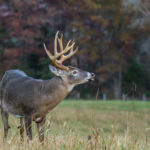
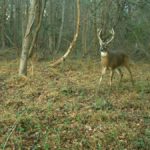
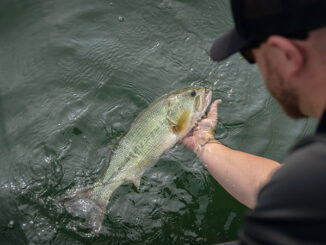
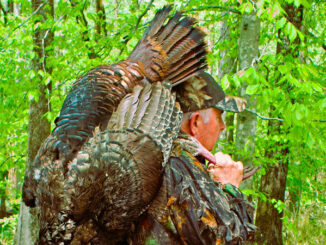
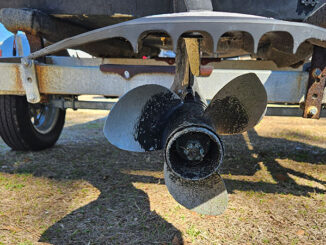

Be the first to comment